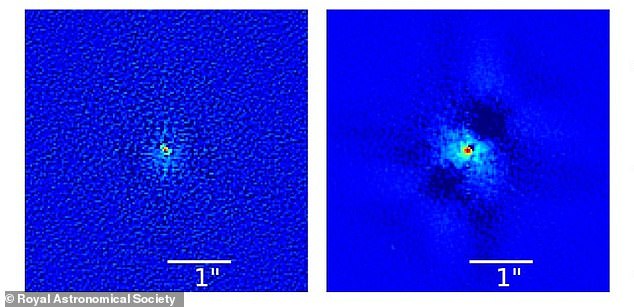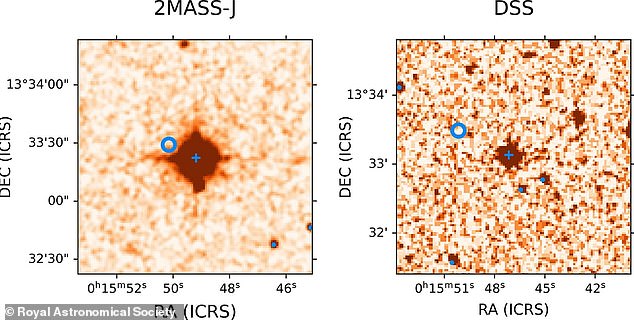NASA has discovered an Earth-like planet 40 light years away that could be a promising candidate for hosting human life.
The exoplanet, called Gliese 12 b, is slightly smaller than our planet and has an estimated surface temperature of 107 degrees Fahrenheit, assuming it has no atmosphere.
Gliese 12 b lies just inside the habitable zone, the distance from a star at which liquid water could exist on the surfaces of orbiting planets.
Astronomers now plan to analyze Gliese 12 b to determine whether it has an Earth-like atmosphere, which could reveal whether the exoplanet can maintain the right temperature for water to form on its surface, a compound essential for supporting life.
Gliese 12 b has been labeled “the closest transiting, temperate, Earth-sized world to date” and is a candidate for future exploration by NASA’s $9.5 billion James Webb Space Telescope. of dollars.
An international team of astronomers discovered Gliese 12 b, an exoplanet that is 40 light years from Earth and has a surface temperature of 107 degrees Fahrenheit. In the photo: Image of the location of Gliese 12 b in 1998 (left) and 1949 (right)
An international team of astronomers used NASA’s TESS (Transiting Exoplanet Survey Satellite) to narrow down the location of Gliese 12 b.
These discoveries are commonly made using the “transit method”, when the planet crosses in front of its star, causing a drop in its brightness.
During the exoplanet’s transit, light from the star passes through its atmosphere, absorbing some of the wavelengths that release gas molecules that telescopes, such as the James Webb, can detect.
The team discovered that Gliese 12 b has a much narrower orbit than Earth, meaning it crosses its cool red dwarf star, called Gliese 12, more frequently, completing an orbit every 12.8 days.
“Gliese 12 b represents one of the best targets to study whether Earth-sized planets orbiting cool stars can retain their atmospheres, a crucial step in advancing our understanding of the habitability of planets in our galaxy,” said Shishir Dholakia, a PhD student at the Center for Astrophysics at the University of Southern Queensland in Australia.
The exoplanet’s distance to its dwarf star is only seven percent of the distance between Earth and the Sun, giving it 1.6 times more energy.
However, Gliese 12 b’s habitable conditions depend on whether it has the same type of atmosphere as Earth, making its temperature closer to the average 59 degrees Fahrenheit found on our planet.

Astronomers have discovered approximately 5,000 exoplanets, but estimate there are probably more than a trillion in the Milky Way alone. In the photo: location of Gliese 12 b
“Atmospheres trap heat and, depending on the type, can substantially change the actual surface temperature,” Dholakia explained.
‘We are quoting the ‘equilibrium temperature’ of the planet, which is the temperature the planet would have if it had no atmosphere.
The team compared Gliese 12 b to Venus and reported that it is about the same size and receives slightly less energy from its star: about 85 percent.
But because Venus does not have an atmosphere to block the sun’s harmful rays, it developed a greenhouse effect, reaching temperatures of 752 degrees Fahrenheit.
“Earth is habitable, but Venus is not because of its total loss of water,” said Larissa Palethorpe, a PhD student at the University of Edinburgh and University College London.
“Since Gliese 12 b has a temperature between Earth and Venus, its atmosphere could teach us a lot about the habitability pathways that planets follow as they develop,” he added.
An important factor in understanding whether the exoplanet could be habitable is to observe the level of storms emitted by its star.
Typically, red dwarf stars are magnetically active, causing them to project frequent X-ray flares that could destroy the atmosphere.
However, teams have high hopes that this is not the case because the Gliese 12 star has not shown any signs of extreme storms or behavior.
Astronomers have already discovered approximately 5,000 of these planets, but estimate that there are likely more than a trillion exoplanets in the Milky Way alone; Until now, only a few are believed to have the environment necessary to sustain life.
“We only know of a handful of temperate Earth-like planets that are close enough to us and meet other criteria needed for this type of study,” said Michael McElwain, a research astrophysicist at NASA’s Goddard Space Flight Center and co-author of the study. . from the Gliese 12 study b.
“To better understand the diversity of atmospheres and the evolutionary outcomes of these planets, we need more examples like Gliese 12 b,” he added.

